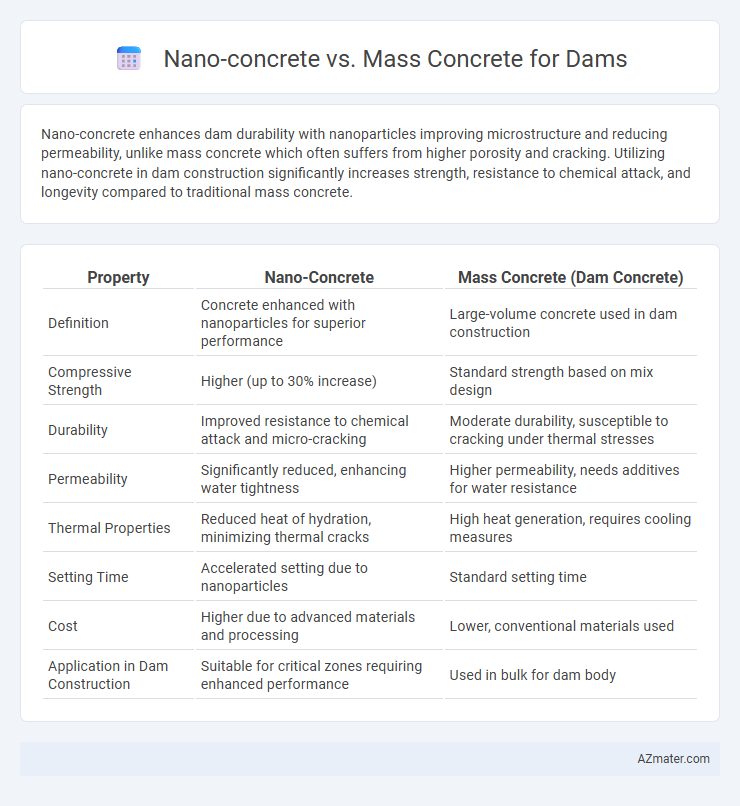Nano-concrete enhances dam durability with nanoparticles improving microstructure and reducing permeability, unlike mass concrete which often suffers from higher porosity and cracking. Utilizing nano-concrete in dam construction significantly increases strength, resistance to chemical attack, and longevity compared to traditional mass concrete.
Table of Comparison
| Property | Nano-Concrete | Mass Concrete (Dam Concrete) |
|---|---|---|
| Definition | Concrete enhanced with nanoparticles for superior performance | Large-volume concrete used in dam construction |
| Compressive Strength | Higher (up to 30% increase) | Standard strength based on mix design |
| Durability | Improved resistance to chemical attack and micro-cracking | Moderate durability, susceptible to cracking under thermal stresses |
| Permeability | Significantly reduced, enhancing water tightness | Higher permeability, needs additives for water resistance |
| Thermal Properties | Reduced heat of hydration, minimizing thermal cracks | High heat generation, requires cooling measures |
| Setting Time | Accelerated setting due to nanoparticles | Standard setting time |
| Cost | Higher due to advanced materials and processing | Lower, conventional materials used |
| Application in Dam Construction | Suitable for critical zones requiring enhanced performance | Used in bulk for dam body |
Introduction to Dam Construction Materials
Nano-concrete incorporates nanoparticles such as silica fume and nano-silica to enhance strength, durability, and permeability, making it highly suitable for advanced dam construction. Mass concrete, traditionally used in dam construction, relies on large volumes of ordinary Portland cement and aggregates, offering high compressive strength but often facing issues like thermal cracking due to heat of hydration. Selecting appropriate materials depends on project requirements, with nano-concrete providing improved mechanical properties and reduced maintenance compared to conventional mass concrete.
Defining Nano-Concrete and Mass Concrete
Nano-concrete incorporates nanoparticles to enhance the microstructure, resulting in superior strength, durability, and reduced permeability compared to traditional concrete. Mass concrete refers to large volumes of concrete used in dam construction, characterized by slow heat dissipation and potential thermal cracking due to its bulk size. Understanding the distinct properties of nano-concrete and mass concrete is crucial for optimizing dam performance and longevity.
Key Differences in Composition
Nano-concrete incorporates nanoparticles such as nano-silica or nano-alumina into its mix, enhancing the material's microstructure and mechanical properties, while mass concrete relies on conventional aggregates, cement, and water without nanoscale additives. The nanoparticles in nano-concrete dramatically increase surface area and reactivity, leading to improved strength, reduced porosity, and better durability compared to mass concrete. Mass concrete typically requires large volumes and controlled cooling to manage thermal stresses, whereas nano-concrete's optimized composition allows for superior performance in smaller quantities with enhanced longevity.
Strength and Durability Comparison
Nano-concrete exhibits significantly higher compressive strength and enhanced durability compared to mass concrete due to the incorporation of nanoparticles that optimize the hydration process and reduce porosity. The refined microstructure of nano-concrete results in improved resistance to chemical attacks, freeze-thaw cycles, and abrasion, making it ideal for dam construction in harsh environments. Mass concrete, while effective for large-volume applications, typically demonstrates lower strength and greater vulnerability to cracking and durability issues over time.
Performance in Extreme Conditions
Nano-concrete exhibits superior durability and mechanical strength compared to mass concrete when used in dam construction, particularly under extreme environmental stressors such as freeze-thaw cycles and high hydraulic pressure. The incorporation of nanoparticles enhances microstructural density, resulting in reduced permeability and increased resistance to chemical attack and cracking. Mass concrete, while effective for large-volume pours, often lacks the advanced durability features necessary for long-term performance in harsh climatic and operational conditions of dams.
Environmental Impact of Each Material
Nano-concrete exhibits significantly lower environmental impact compared to mass concrete due to its reduced material consumption and enhanced durability, leading to decreased carbon emissions over the dam's lifecycle. The incorporation of nano-sized particles optimizes hydration processes, resulting in lower cement content and reduced greenhouse gas emissions during production. Mass concrete, while traditional and widely used, demands larger quantities of cement and aggregates, generating higher embodied carbon and contributing to greater environmental degradation.
Cost Implications and Economic Feasibility
Nano-concrete offers enhanced strength and durability compared to mass concrete, reducing maintenance and repair costs over the dam's lifespan, which significantly improves economic feasibility. While the initial material and production expenses for nano-concrete are higher due to advanced nanomaterials and technology, the long-term savings on lifecycle costs and potential extension of service life justify the investment. Mass concrete remains cost-effective for large volume applications but may incur higher costs related to frequent maintenance and shorter durability in harsh dam environments.
Technological Advancements in Concrete Solutions
Nano-concrete incorporates nanoparticles to enhance microstructural properties, significantly improving the compressive strength and durability of dam structures compared to traditional mass concrete. Advanced technological innovations in nano-engineered materials allow for reduced permeability and increased resistance to chemical attacks, leading to longer service life and reduced maintenance costs. These developments position nano-concrete as a cutting-edge solution for high-performance dam construction, offering superior mechanical properties and enhanced sustainability over conventional mass concrete.
Case Studies: Nano-Concrete vs Mass Concrete in Dams
Case studies on dams highlight that nano-concrete significantly improves durability, permeability resistance, and early strength compared to traditional mass concrete. Projects like the Three Gorges Dam and Hoover Dam retrofitting demonstrate nano-concrete's superior microstructural integrity and enhanced resistance to cracking under high stress conditions. These findings confirm nano-concrete's potential for extending the lifespan and reliability of large-scale dam structures.
Future Trends and Recommendations
Nano-concrete exhibits superior durability, reduced permeability, and enhanced mechanical properties compared to mass concrete, making it a promising material for next-generation dam construction. Future trends emphasize integrating nanomaterials such as nano-silica and carbon nanotubes to improve self-healing capabilities and resistance to environmental degradation in dam structures. Researchers recommend adopting advanced nano-concrete formulations coupled with smart monitoring systems to extend dam lifespan and optimize structural performance under extreme conditions.

Infographic: Nano-concrete vs Mass concrete for Dam
 azmater.com
azmater.com